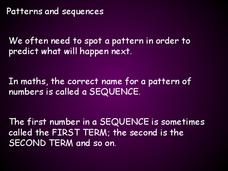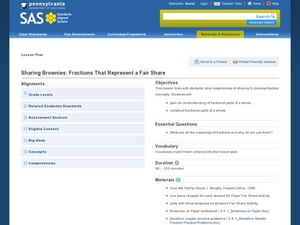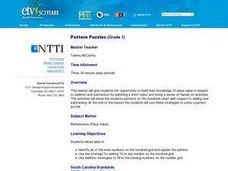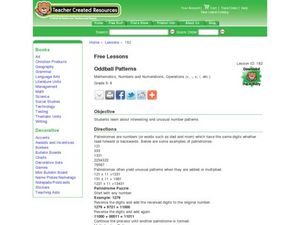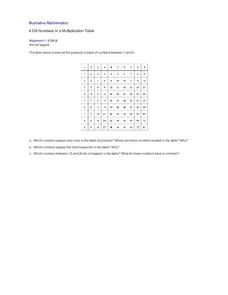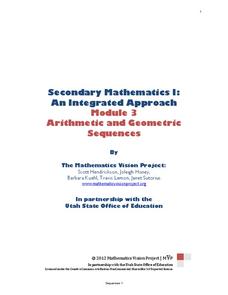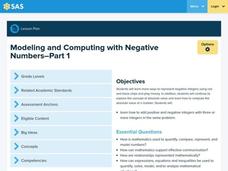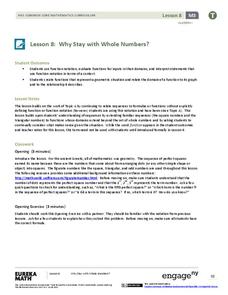Scholastic
Study Jams! Number Patterns
Finding patterns is an essential skill for mathematicians of all ages. Follow along with Zoe as she walks step-by-step through the process of identifying and completing number patterns. Work through the Try It! problems as a whole class...
All Our Days
Duplo/Lego Tower Pattern Busy Bag
Turn young learners into pattern detectives with this fun hands-on activity. Using the included set of cards showing different block towers, children replicate each pattern with their own manipulatives while...
Curated OER
Identifying Patterns
Although this fractions exercise may seem difficult at first, it's really quite simple and intended for beginners to mixed numbers. Scholars complete 15 number sequences by adding two or three mixed numbers or decimal numbers. However,...
Scholastic
Study Jams! Place Value
Looking at large numbers can intimidate many young mathematicians. Use Zoe's place value machine to help learners understand the meaning behind each digit in a whole number. After learning about the ones, tens, and hundreds places,...
Curated OER
Patterns and Sequences
A very well done slide-show defines and explains how numeric patterns and sequences work. Academic vocabulary is highlighted as well as solid examples and whole class practice. The last slide contains four number sequences for the class...
EngageNY
Even and Odd Numbers
Even or not, here I come. Groups investigate the parity of products and sums of whole numbers in the 17th lesson plan in a series of 21. Using dots to represent numbers, they develop a pattern for the products of two even numbers; two...
Curated OER
Sharing Brownies: Fractions That Represent a Fair Share
Elementary graders discover the concept of fractional pieces of a whole. They investigate the meanings of fractions in everyday life and why they are used. Pupils divide brownies amongst each other to demonstrate the use of fractions...
Math Flix
MathFLIX Challenge: Multiplying and Dividing Fractions
First, math majors compare the multiplication and division of unit fractions and whole numbers. They look for patterns, and then apply their knowledge to an array of multiplication and division problems, all involving fractions and...
CK-12 Foundation
Sums of Finite Arithmetic Series: Triangular Numbers
Using a slider, scholars build triangular numbers and their associated rectangles and use the geometric display to find the pattern to determine the next triangular number. They then relate that number to the area of the rectangle to...
Math Mammoth
Add & Subtract Whole Hundreds 1
In this mathematics worksheet, 3rd graders compare the problem 2700 plus 200 to the problem 27 plus 2 and explain their reasoning. Then they notice the patterns for each of the problems and continue them.
Curated OER
Add It Up In Number Ville! Adding 2-Digit Numbers With and Without Regrouping
Young scholars explore adding 2-digit numbers. In this math lesson, students identify 2-digit numbers and use base ten blocks to practice adding. Young scholars use addition to break a code.
Curated OER
Number Patterns
Help your students to identify even and odd numbers. In this number sense lesson, they read the book Madeline and use counters to identify which number has a "partner." Learners write down odd and even numbers on a whiteboard.
Curated OER
Pattern Puzzles
A short video introduces place value in addition and subtraction. As a class, your students identify all even numbers up to one hundred and explain the pattern. They use addition strategies to fill in the missing numbers on the number grid.
Curated OER
Vegetable Print Patterns
Create a unique print using vegetable stencils and tempera paints applied to grid like pattern formed from cut pieces of paper. Your students will choose either a warm or a cool color scheme.
Curated OER
Oddball Patterns
Investigating unique number patterns gets learners to put their thinking caps on. Your whole class examines numerical palindromes that are added and multiplied. The class works to find the pattern.
Curated OER
Patterns in the Multiplication Table
Explore patterns in the multiplication table in order to deepen your third graders' understanding of this essential skill. Implement this activity as a whole-class lesson, allowing students to work in pairs or small groups to support...
Illustrative Mathematics
Numbers in a Multiplication Table
Identifying patterns is a crucial skill for all mathematicians, young and old. Explore the multiplication table with your class, using patterns and symmetry to teach about square numbers, prime numbers, and the commutative and identity...
Curated OER
Using Numbers Everywhere
Kindergarteners explore various representations and uses of numbers to develop number sense. They participate in an activity and arrange patterns into groups. Students compare the sets and describe the objects in each set.
Curated OER
Math Series: Number Patterns
The focus of this math lesson is representing numbers in different ways. Young mathematicians practice putting numbers into sets, and arriving at answers in new ways. For example, they are asked to, "Show me how to get 7 eyes." A...
Curated OER
Fractions and Recipes
Learners, working with their parents in real world situations, calculate to complete three word problems associated with multiplying and dividing fractions.
Virginia Department of Education
Complex Numbers
Build on your class' understanding of real numbers as they begin working with complex numbers. Pupils begin with an exploration of i and the patterns in the powers of i. After developing a definition for i, they...
Mathematics Vision Project
Module 3: Arithmetic and Geometric Sequences
Natural human interest in patterns and algebraic study of function notation are linked in this introductory unit on the properties of sequences. Once presented with a pattern or situation, the class works through how to justify...
Curated OER
Dividing with Fractions
Use paper strips or models to relate division problems to division of fraction problems. Since the materials can be broken up, it helps them to show how they can complete repeated subtraction with fractions and not just whole numbers.
EngageNY
Why Stay with Whole Numbers?
Domain can be a tricky topic, especially when you relate it to context, but here is a lesson that provides concrete examples of discrete situations and those that are continuous. It also addresses where the input values should begin and...






